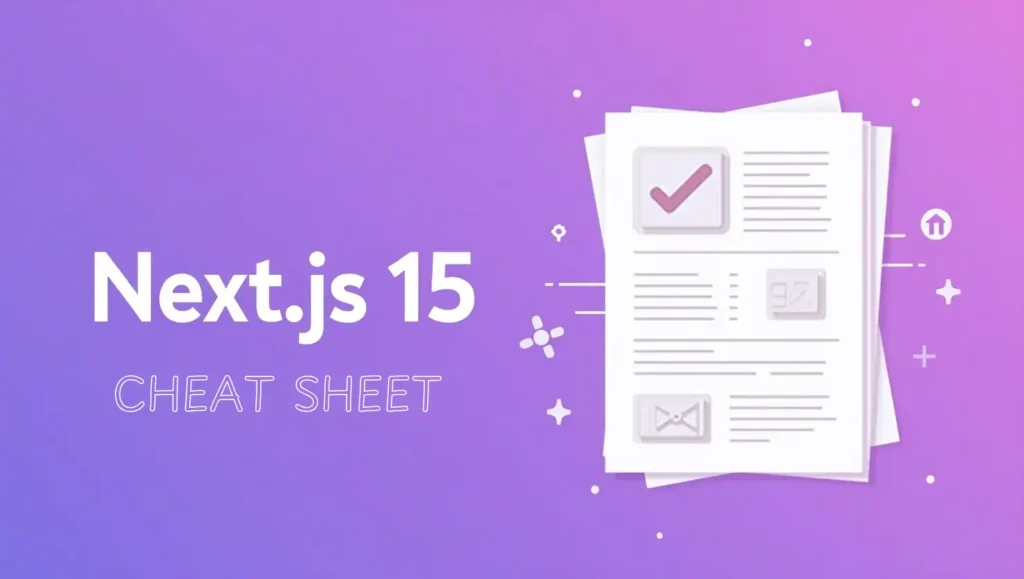
Welcome to the ultimate Next.js 15 Cheat Sheet, the ready reference for the new features and changes in Next.js 15.
Key Features & Improvements
1. React 19 (Optional Canary Support)
- Try out the new React 19 features like Actions, use() , and Optimistic Updates.
- To enable React 19 in your Next.js 15 project, add this to your config:
// next.config.js
module.exports = { experimental: { reactCompiler: true } }Why It Matters: Experiment with future React features today while keeping your app stable. Great for early adopters!
2. Partial Prerendering (PPR)
- Mix static and dynamic content on the same page.
- Example:
// app/page.js
export default function Page() {
return (
<div>
{/* Static: Loads instantly */}
<StaticHeader />
{/* Dynamic: Loads later */}
<Suspense fallback="Loading..."><LiveData /></Suspense>
</div>
);
}- To enable, add this to your config:
experimental: { ppr: true }Why It Matters: Users see pages instantly (static parts) while dynamic content loads quietly. Boosts SEO and user retention!
3. Turbopack (Stable for Dev)
- Super-fast local development.
next dev --turbo # Cold starts now take around 2 secondsWhy It Matters: Developers save hours monthly waiting for builds. Ideal for large projects!
4. Async Request APIs
- You can now use await for headers, cookies, and URL params.
// app/page.js
export default async function Page({ params }) {
const slug = await params.slug;
return <div>{slug}</div>;
}Why It Matters: Prevents UI freezes during data fetching. Smoother user experiences!
5. Caching Changes
- By default, fetch() and GET routes no longer cache.
- To force caching, use this:
fetch(url, { cache: 'force-cache' }); // This mimics the old behaviorWhy It Matters: Fresh data by default for real-time apps (e.g., dashboards), while keeping blogs fast. Best of both worlds!
6. Improved Hydration Errors
- More descriptive error messages to help you spot mismatches like: “Server: ‘Submit’ vs Client: ‘Send’”
Why It Matters: Fix bugs 2x faster with precise error locations. No more guessing games!
7. Experimental unstable_after
- Run tasks after sending a response (e.g., send emails in the background):
// app/api/signup/route.js
import { unstable_after as after } from 'next/server';
export async function POST() {
after(() => { console.log('Email sent!') });
return Response.json({ success: true });
}Why It Matters: Handle background tasks (emails/analytics) without slowing users. Perfect for e-commerce!
8. TypeScript in Config
- Add types to your next.config.ts :
import type { NextConfig } from 'next';
const config: NextConfig = { /*...*/ };
export default config;Why It Matters: Catch config errors before deployment. Essential for teams!
9. Security Enhancements
- Server Actions now auto-generate unique IDs to prevent tampering.
Why It Matters: Blocks malicious form submissions. Critical for login/checkout flows!
10. ESLint 9 Support
- Update ESLint for better compatibility:
npm install eslint@latestWhy It Matters: Stricter rules catch bugs early. Keep codebases clean!
Breaking Changes
- @next/font is removed; use next/font instead.
- bundlePagesRouterDependencies has been renamed to bundleAppRouterDependencies .
- serverExternalPackages is now correctly spelled (was a typo before).
How to Upgrade
1. Update Packages:
npm install next@latest react@latest react-dom@latest eslint-config-next@latest2. Run Codemods (Automate fixes):
npx @next/codemod@latest next-async-request-api .3. Test Caching:
- Add cache: ‘force-cache’ to critical fetch calls.
- Check your route handlers for explicit caching.
4. Check Async APIs:
- Don’t forget to add await to headers(), cookies(), and searchParams.
FAQs
Is React 19 required?
No! You can use Next.js 15 with React 18.2 or later. React 19 is optional.
How do I fix caching issues?
Add cache: ‘force-cache’ to your fetch requests or use the experimental unstable_cache .
Why are my .env variables missing?
.env files are now ignored by default. Use .env.local instead.
Can I use Next.js 15 with my old code?
Yes! It’s backward-compatible, but make sure to test for deprecated API warnings.
How do I debug hydration errors?
Next.js 15 now gives you clear messages pointing to the exact component with mismatches.
Pro Tips
- Use next dev –turbo for faster local development.
- Migrate incrementally—no need to rewrite everything all at once.
- For SEO, combine static content (PPR) with dynamic widgets.
Bookmark this cheat sheet!
To dive deeper into mastering Next.js 15, check out my full guide here: A Guide to understand Next.js 15: Master New Features with Simple Examples & Tips
For the official documentation on Next.js 15, visit: Next.js 15 Documentation
